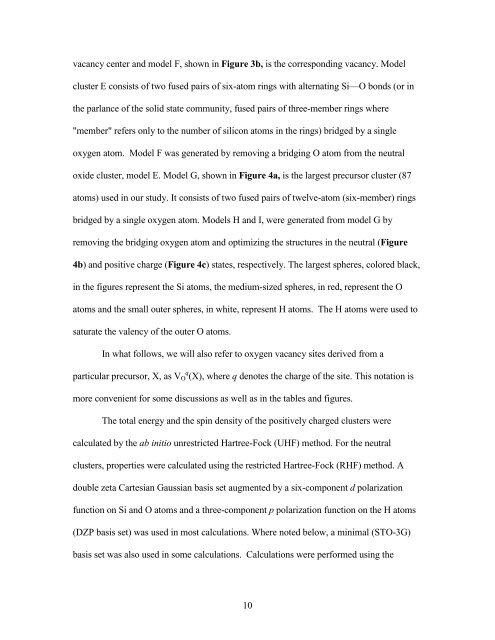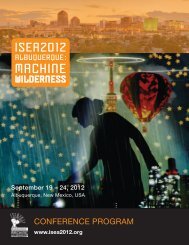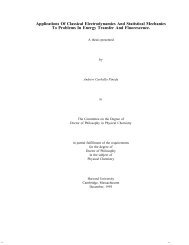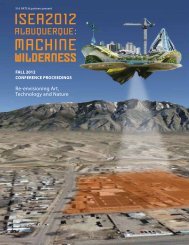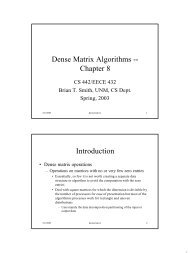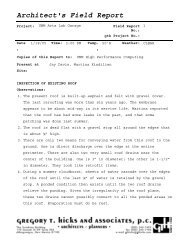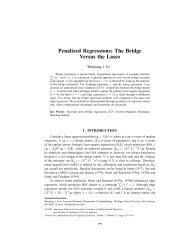Electronic Structure Theory of Radiation-Induced Defects in Si/SiO2
Electronic Structure Theory of Radiation-Induced Defects in Si/SiO2
Electronic Structure Theory of Radiation-Induced Defects in Si/SiO2
You also want an ePaper? Increase the reach of your titles
YUMPU automatically turns print PDFs into web optimized ePapers that Google loves.
vacancy center and model F, shown <strong>in</strong> Figure 3b, is the correspond<strong>in</strong>g vacancy. Model<br />
cluster E consists <strong>of</strong> two fused pairs <strong>of</strong> six-atom r<strong>in</strong>gs with alternat<strong>in</strong>g <strong>Si</strong>—O bonds (or <strong>in</strong><br />
the parlance <strong>of</strong> the solid state community, fused pairs <strong>of</strong> three-member r<strong>in</strong>gs where<br />
"member" refers only to the number <strong>of</strong> silicon atoms <strong>in</strong> the r<strong>in</strong>gs) bridged by a s<strong>in</strong>gle<br />
oxygen atom. Model F was generated by remov<strong>in</strong>g a bridg<strong>in</strong>g O atom from the neutral<br />
oxide cluster, model E. Model G, shown <strong>in</strong> Figure 4a, is the largest precursor cluster (87<br />
atoms) used <strong>in</strong> our study. It consists <strong>of</strong> two fused pairs <strong>of</strong> twelve-atom (six-member) r<strong>in</strong>gs<br />
bridged by a s<strong>in</strong>gle oxygen atom. Models H and I, were generated from model G by<br />
remov<strong>in</strong>g the bridg<strong>in</strong>g oxygen atom and optimiz<strong>in</strong>g the structures <strong>in</strong> the neutral (Figure<br />
4b) and positive charge (Figure 4c) states, respectively. The largest spheres, colored black,<br />
<strong>in</strong> the figures represent the <strong>Si</strong> atoms, the medium-sized spheres, <strong>in</strong> red, represent the O<br />
atoms and the small outer spheres, <strong>in</strong> white, represent H atoms. The H atoms were used to<br />
saturate the valency <strong>of</strong> the outer O atoms.<br />
In what follows, we will also refer to oxygen vacancy sites derived from a<br />
particular precursor, X, as V q O (X), where q denotes the charge <strong>of</strong> the site. This notation is<br />
more convenient for some discussions as well as <strong>in</strong> the tables and figures.<br />
The total energy and the sp<strong>in</strong> density <strong>of</strong> the positively charged clusters were<br />
calculated by the ab <strong>in</strong>itio unrestricted Hartree-Fock (UHF) method. For the neutral<br />
clusters, properties were calculated us<strong>in</strong>g the restricted Hartree-Fock (RHF) method. A<br />
double zeta Cartesian Gaussian basis set augmented by a six-component d polarization<br />
function on <strong>Si</strong> and O atoms and a three-component p polarization function on the H atoms<br />
(DZP basis set) was used <strong>in</strong> most calculations. Where noted below, a m<strong>in</strong>imal (STO-3G)<br />
basis set was also used <strong>in</strong> some calculations. Calculations were performed us<strong>in</strong>g the<br />
10


